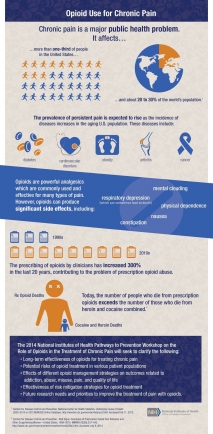Opioid prescriptions have increased three-fold over the past two decades, and we have seen how this skyrocketing availability of medications has helped create a new drug abusing population, some of whom suffer severe health consequences. More deaths now occur as a result of overdosing on prescription opioids than from all other drug overdoses combined, including heroin and cocaine. The opioid epidemic is tied closely to another epidemic in our country, that of chronic pain—although the ties are very complex.
Chronic pain now affects more than a third of Americans (see Infographic below). Although chronic pain patients themselves account for only a small percentage of those who are abusing opioid painkillers and dying from them, these pain sufferers may not even be obtaining significant benefit from the opioids used to treat their condition. In fact, growing evidence suggests that long-term treatment with opioids may induce hyperalgesia, an increase in pain sensitivity as a result of the chronic administration of opioid medications, at least in some patients.
 Chronic pain is a major public health problem. It affects more than one-third of the U.S. and 20%-30% of the world's population. Prevalence of persistent pain is expected to rise with the increase in diabetes, cardiovascular disorders, obesity, arthritis and cancer in the aging U.S. population. Opioids can produce significant side effects such as respiratory depression, mental clouding, nausea, constipation and physical dependence. Opioid prescribing has increased 300% in the last 20 years. Today, the number of people who die from prescription opioids exceeds the number from heroin and cocaine combined. Download a larger version provided by the NIH Prevention site (PDF, 3.8 MB).
Chronic pain is a major public health problem. It affects more than one-third of the U.S. and 20%-30% of the world's population. Prevalence of persistent pain is expected to rise with the increase in diabetes, cardiovascular disorders, obesity, arthritis and cancer in the aging U.S. population. Opioids can produce significant side effects such as respiratory depression, mental clouding, nausea, constipation and physical dependence. Opioid prescribing has increased 300% in the last 20 years. Today, the number of people who die from prescription opioids exceeds the number from heroin and cocaine combined. Download a larger version provided by the NIH Prevention site (PDF, 3.8 MB). This year, the Agency for Healthcare Research and Quality reviewed studies on the effectiveness and risks of long-term opioid treatment of chronic pain. The results are eye-opening: No randomized trials or comparative observational studies meeting the reviewers’ criteria were found that addressed opioids’ effectiveness for chronic pain or comparing their effectiveness to other treatments, making it impossible to know whether long-term treatment with opioids adequately addresses patients’ symptoms or improves their functioning or quality of life. At best there was weak evidence regarding optimal dosing strategies with these medications.
I have argued before that opioids are overused and overprescribed because of a lack of clear understanding of how to treat pain by doctors. (Pain management is barely covered in medical schools—a situation that NIDA has worked to help rectify through various initiatives including leading the creation of 11 Centers of Excellence in Pain Education, in partnership with the NIH Pain Consortium and other NIH Institutes.) If it is indeed the case that opioid overtreatment is not only contributing to addiction but also contributing to the chronic pain problem, then that makes all the more urgent the need to investigate new treatment approaches and perhaps even create new medications that operate on other signaling systems in the body.
On September 29-30, NIDA along with the NIH Pain Consortium, the NIH Office of Disease Prevention, and the National Institute of Neurological Disorders and Stroke is cosponsoring a Pathways to Prevention workshop to discuss what we know and don’t know about opioids in the management of chronic pain. Participants will discuss the effectiveness and potential risks of long-term opioid treatment for different patient populations, different pain management strategies and their outcomes, ways of limiting opioids’ risks, and our future research needs.
Get more information on the workshop, The Role of Opioids in the Treatment of Chronic Pain. You can also see my video on pain research at NIDA and the NIH Pain Consortium (below).
